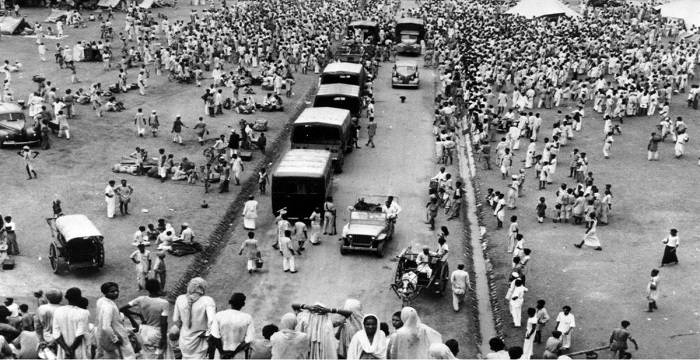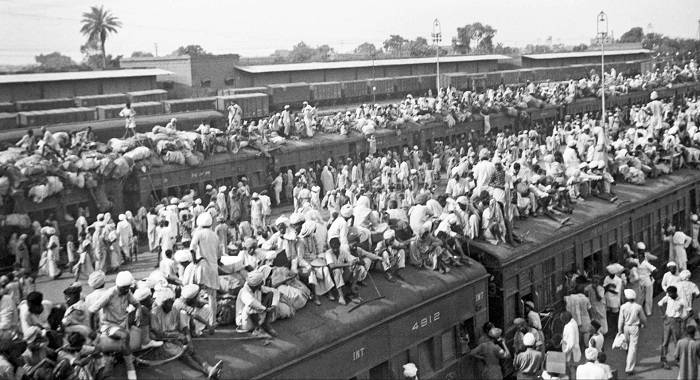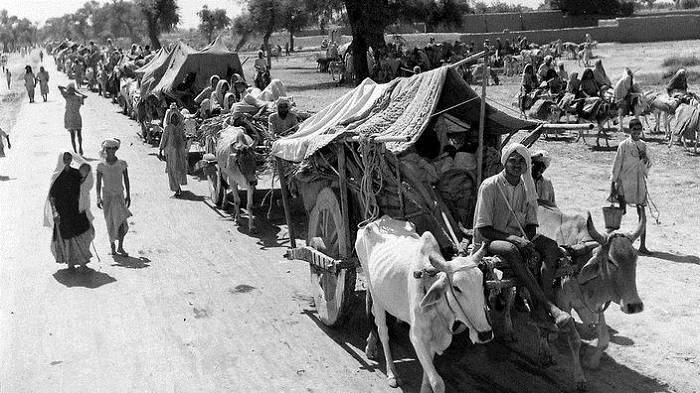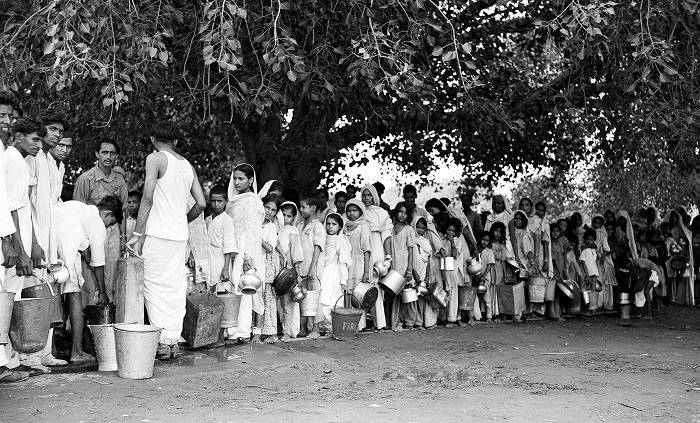The Partition of India was the division of the Presidencies and Provinces of British India conceived under the two-nation theory that resulted in formation of two independent dominions, India and Pakistan, in the British Commonwealth of Nations. The Indian Independence Act 1947 partitioned British India bringing an end of the British Raj. At midnight of 14–15 August 1947, India and Pakistan emerged legally as two self-governing countries. Based on Hindu and Muslim majorities three provinces namely Bengal, Assam and Punjab were divided that led to displacement of more than 14 million people paving way for an insurmountable refugee crisis, mass-scale violence, killings and disruption over religious lines. The Dominion of India was transformed into the Republic of India in 1950 while the Dominion of Pakistan that was administratively divided into West Pakistan and East Pakistan became the Islamic Republic of Pakistan in 1956. East Pakistan later seceded from the union in 1971 to become Bangladesh.
Circumstances & Events Leading to Partition of India
Partition of Bengal
The then Viceroy of India, Lord Curzon asked Queen Victoria to separate Bengal. Although there was no doubt that with a population of 70 million, administering Bengal was gradually becoming difficult, however with the real objective behind such division was political as the British feared a war if the Bengali Hindus and Muslims join hands. As the Indian independence movement was gaining momentum, the British wanted to weaken Bengal which was considered the nerve centre of Indian nationalism. Curzon announced the decision of dividing Bengal on July 19, 1905. Accordingly the Bengal Presidency, the largest administrative subdivision of British India, was divided on October 16, that year into largely Hindu western areas of Bengal that presently form the Indian states of West Bengal, Odisha, Bihar and Jharkhand; and the largely Muslim eastern areas of East Bengal and Assam. By dividing Bengal in this manner, the British not only thrived in restraining the Bengali influence in India’s freedom struggle but also reduced the Bengalis into a minority in the Hindu western areas of Bengal with around 37 million Oriya and Hindi speaking people compared to 17 million Bengalis.

Image Credit : https://www.thoughtco.com/what-was-the-partition-of-india-195478
The partition was not taken well by both the elites as well as the large middle-class from the Hindu Bengali community who recognised it as a “divide and rule” policy. Spontaneous and sporadic protests across Bengal followed. The protests took shape of Swadesi (“buy Indian”) movement. People boycotted British products, leaders of the anti-partition movement resolved to use Indian goods, foreign goods shops were picketed, western products including clothes were thrown on bonfires and imported sugar was also boycotted. The anti-partition movement leaders used the title of a Bengali poem written by Bankim Chandra Chatterjee ‘Vande Mataram’ meaning “I praise thee, Mother” as their slogan. A song was composed from the poem by Rabindranath Tagore. The Congress Working Committee later (in October 1937) adopted the first two verses of the song as the National Song of India. Public buildings were bombed, armed robberies were staged and British officials were murdered by group of young men. Soon the slogan and the revolts garnered nationwide attention.
The Muslim elites on the other hand met the new viceroy, Lord Minto in 1906 and asked for separate electorates for Muslims as also proportional legislative representation for them. They founded the All Indian Muslim League political party in December 1906 conference in Dhaka that was hosted by Nawab Sir Khwaja Salimullah and held at Ahsan Manzil, the official residence of the Dhaka Nawab Family. Lord Hardinge later re-united the two parts of Bengal on December 12, 1911, in face of political protests as well as to appease the sentiment of the Bengalis.
Role of British Indian Army during First World War, Lucknow Pact & The Government of India Act of 1919
Contribution of the British Indian Army during the First World War (July 28, 1914 – November 11, 1918) was immense which included involvement of huge number of independent brigades and divisions in major military activity areas in Europe, the Mediterranean and in the Middle East. News of participation of Indian troops in the war including death of thousands of Indian soldiers reached across the globe through newsprint and radio garnering worldwide rise in the international profile of India. In 1920, India became one of the founding members of League of Nations, the principal mission of which was to maintain world peace. India also took part in the 1920 Summer Olympics in Antwerp under the name, “Les Indes Anglaises” (British India). The Indian leaders were increasingly pressing for constitutional reforms in India since the late 19th century. They demanded a greater role in the government in India. After the Indian Army contribution during the First World War, the conservative British political leaders also started acknowledging the need of constitutional change so that participation of Indians in the government of the British Indian Empire can be increased.

Image Credit :https://www.thesun.co.uk/news/4238978/partition-of-india-1947-pakistan-border/
Meanwhile a joint session was held by the Muslim League and Congress in December 1916 in Lucknow where an agreement famously known as the Lucknow Pact was reached. In pursuit of demanding Indian autonomy, the two parties agreed to permit proportionately higher representation of religious minorities in the provincial legislatures through the pact. The pact was considered a significant milestone in the Indian Independence movement as it established cordial relations between the Indian National Congress and the Muslim League and ignited a ray of hope for Hindu Muslim unity.
In pursuit of expanding participation of Indians in the government of India, the Government of India Act, 1919 was passed which received Royal Assent on December 23 that year. Also famous as the Montagu–Chelmsford Reforms, the Act consisted of reforms advised in the report of the Viceroy, Lord Chemlsford and the Secretary of State for India, Edwin Montagu. It introduced a diarchy for the major provinces where control of some areas of government, included in the “transferred list” like agriculture, education, health and supervision of local government, in each such province would be controlled by Government of ministers who would be accountable to the Provincial Council. A ‘’reserved list’’ including other areas of government like foreign affairs, defence (the military) and communications would be controlled by the Viceroy. The Act also made admission of Indians into the civil service as well as in the army officer corps easier and reserved seats in both provincial and imperial legislative councils for domiciled Europeans, Anglo-Indians, Indian Christians, Muslims and Sikhs reaffirming the principle of “communal representation” from the Minto-Morley Reforms. However only partial transfer of power was provided to the ministers responsible to the provinces and control over money in such areas were still in the hands of the British officialdom.
Two-Nation Theory
The very creation of Pakistan was based on the principle of the two-nation theory that remained one of the founding principles of the Pakistan Movement. According to the ideology of two-nation, the Indian Hindus and Muslims are two distinct nations irrespective of their specific area-wise commonalities including language and ethnicity and the primary identity and factor that unifies the Indian subcontinent Muslims is their religion. Thus the theory advocated for a distinct homeland for Muslims in the Muslim majority areas of India where they can practice Islam as the dominant religion. Lawyer and politician Muhammed Ali Jinnah who remained leader of the All-India Muslim League and played an instrumental role in curving out a separate nation for Muslims in the Indian subcontinent as Pakistan undertook and championed the ideology.
Several Hindu nationalist organizations were also influenced by the theory. The different reasons that motivated them included re-describing the Indian Muslims as second-class citizens in India and even to the extent of non-Indian foreigners; driving out the entire Muslim community from India; legally setting up a Hindu state in India; restricting conversions to Islam; and championing shuddhi that is conversion to Hinduism among Indian Muslims. One of the prominent freedom fighters of India, Lala Lajpat Rai, who remained leader of Hindu Mahasabha, which was formed to protect rights of the Hindu community in British Raj after forming of All India Muslim League, remained among the first Hindu proponents to back the two-nation theory. He controversially wrote in the Indian English-language daily newspaper ‘The Tribune’ on December 14, 1924, demanding a clear division of India into a Hindu State India and a Muslim India. Interpretations of the theory varied. While one advocated for a transfer of population that is removal of the entire Hindu community from Muslim-majority areas and vice-versa, another interpretation contended for sovereign autonomy where such transfer was not required and Hindus and Muslims can continue to co-exist although a seceding right for Muslim-majority areas of the Indian subcontinent was included.

Image Credit : https://www.dkfindout.com/us/history/modern-india/partition-india/
Government of India Act 1935, Second World War, Lahore Resolution & Quit India Movement
The Government of India Act, 1935 was passed initially in August 1935. Vital aspects of the Act included abolition of the diarchy system of the 1919 Act and introduction of diarchy at the Centre granting more autonomy to the British Indian provinces; setting up of a Federal Court; provision for setting up a “Federation of India”; introduction of advisory council while annulling Indian Council; initiating direct elections; instruments safeguarding minorities; and partially restructuring provinces. During the winter of 1936-37, provincial elections were held in British India when Indian National Congress came to power in eight provinces out of eleven while the All-India Muslim League were unsuccessful in forming government in any province. Setting up of elected governments however could not be made possible in most princely states because of defiance of the princes. Although Congress maintained that religious matters does not hold much significance to the Indians compared to economic and social matters, certain incidents gradually distanced the party from the Muslim masses in different areas. In one such incident the newly formed provincial administration of UP promulgated protection of cow as also the use of Hindi. Investigations were conducted by the Muslim League in provinces governed by Congress to assess the condition of Muslims. The Muslims gradually became concerned that in future they will be dominated and treated unjustly by the Hindus under the Congress government in independent India. As the Second World War broke in 1939, the then Viceroy of India Lord Linlithgow made an announcement in September 1939 that India was at war with Germany. He announced such a significant decision without consulting the elected representatives of the Indian people. While the Congress ministries resigned in October and November 1939 in protest of such action of the Viceroy, the Muslim League that was operating under the patronage of the state arranged celebrations from dominance of Congress, “Deliverance Day”, and backed Britain in their war effort. Jinnah was given same status as Gandhi by Linlithgow while Congress was labelled as a “Hindu organization”.
A three-day annual session from March 22 to March 24 in 1940 was held by the Muslim League. A formal political statement that became famous as the Lahore Resolution, also referred as “Pakistan Resolution” was adopted by the Muslim League on the last day of its annual session. The resolution envisaged ‘independent states’ for the Muslims in the eastern and northwestern parts of British India where the community was numerically a majority after making required territorial adjustments and also mentioned that the constituent units thus formed should be autonomous and sovereign.
In August 1940 Linlithgow proposed that Dominian status be given to India following the Second World War. In pursuit of garnering support from all Indian communities and parties in its war efforts, the British government also made a proposal famous as the ‘August Offer’ that year. It promised Executive Council expansion of the Viceroy in order to include more Indians, setting up of advisory war council, recognition of right of Indians to frame their own constitution following the war, and to take views of minorities into consideration. The proposal was however rejected by both the Congress and the Muslim League in September that year. The former rejected it as it was in some way providing a veto power to the Muslim League while the latter rejected it as no clear assurance was given in it for establishment of Pakistan. The civil disobedience movement was again revived by the Congress.
On August 8, 1942, in the midst of the Second World War, prominent Indian freedom fighter Mahatma Gandhi launched the Quit India Movement or the India August Movement at the Bombay session of the All-India Congress Committee and demanded an end of the British Raj in India. At the Gowalia Tank Maidan in Bombay while delivering his Quit India speech Gandhi made a Do or Die call. This was followed by mass protest by the All-India Congress Committee. Within hours the British imprisoned the entire leadership of Congress sans any trial and kept most of them in jail till the end of the war secluding them from the masses while the Muslim League freely spread their message.
1946 Elections, Direct Action Day
The new Prime Minister of the United Kingdom Clement Attlee, who backed the issue of Indian independence for years, gave the subject highest priority after assuming office. Back in India several mutinies broke since January 1946 that only led the Attlee government to expedite on the independence issue. Elections were held in India in early 1946 that saw Congress winning 8 of the 11 provinces thereby for most Hindus the Congress emerged as the legitimate successor of the British government. The majority of the Muslim vote and most reserved Muslim seats in the provincial assemblies were won by the Muslim League while securing all Muslim seats in the Central Assembly. Jinnah interpreted this success of the Muslim League as a popular demand of the Muslims for a separate state.

Image Credit : https://www.sbs.com.au/yourlanguage/punjabi/en/article/2017/09/21/pain-long-partition-story-india-and-pakistan
As Congress and Muslim League failed to come to an agreement, a Cabinet Mission Plan was devised by the British to transfer power from the British Raj to the Indian leadership. It proposed to preserve united India which was also desired by the Congress. An alternative plan was however placed by the Muslim League that included division of British India into a Hindu-majority India and a Muslim-majority Pakistan which was completely rejected by the Congress. In protest of such rejection, a general strike was planned by Muslim League on August 16, 1946, called the ‘Direct Action Day’ to display resolute of the Muslims to both Congress and the British. Also known as the ‘Great Calcutta Killings’, the ‘Direct Action Day’ witnessed the worst communal riots in the history of British India till such time. Extensive communal rioting took place in the city of Calcutta (presently Kolkata) in the Bengal province between Muslims and Hindus. The day also initiated ‘The Week of the Long Knives’. The brutality that extended from roads to attacks on women and children at homes continued for three days killing thousands of Hindus and Muslims. Although shocked by such turn of events, a Congress-led interim government was installed in September that year with Jawaharlal Nehru as prime minister of united India. Gradually the communal violence spread and left its mark in Noakhali in Bengal, Bihar, Rawalpindi and Garhmukteshwar in the United Provinces.
Mountbatten Plan, Indian Independence Act 1947, Partition & Independence of India, & the Radcliffe Line
One of the first Congress leaders who saw partition as inevitable was Vallabhbhai Patel also famous as Sardar Patel. He censured the induction of Muslim League ministers into the government as also the Direct Action campaign of Jinnah. He worked with civil servant V. P. Menon from December 1946 to January 1947 on the subject of a separate Muslim-state Pakistan formed out of Muslim-majority provinces. The partition of Punjab and Bengal suggested by Patel garnered considerable support from Indian public.
Lord Louis Mountbatten was appointed by Clement Attlee as the last Viceroy of India on February 20, 1947, and was delegated the responsibility of supervising transition of British India into independent India by June 30, 1948. He was instructed to avoid partition of India maintaining a united India by transferring autonomy and was also advised to adjust to changing situation so as to withdraw British out with minimal reputational damage. After gauging the communal situation Mountbatten also concluded that partition was the only option for quick and orderly transfer of power and a delay may start a civil war. On June 3, 1947, he announced a plan at a press conference famously known as the ‘Mountbatten Plan’ as also the date of independence as August 15, 1947. The plan that included partition of the Muslim-majority provinces of Bengal and Punjab accomplished the actual partition of British India into two separate dominions of India and Pakistan. The areas with Hindu and Sikh majority were assigned to new India while the Muslim-majority areas were assigned for the new state of Pakistan. Patel gave his nod and lobbied with Nehru and other Congress leaders to agree with the plan. Although Gandhi was still against partition, Congress approved the plan and Patel supervised the division of public assets while representing India on the Partition Council. Pakistan garnered one-third of the Indian Army, two of the major metropolitan cities out of six and two-fifth of the Indian railway lines. Patel and Nehru also went on to select the Indian council of ministers. On the other hand the Muslim League also approved the proposal as their demands for a separate state was accomplished. Others including Master Tara Singh representing the Sikhs and B. R. Ambedkar representing the Untouchable community also approved the plan.

Image Credit : http://kuow.org/post/giving-voice-memories-1947-partition-and-birth-india-and-pakistan
The British Parliament on July 18, 1947 passed the Indian Independence Act 1947. The Act led to the partition of British India into the two new independent dominions of India and Pakistan and discarded the suzerainty of the British over the princely states. The independent federal dominion of Pakistan that included two enclaves, East Pakistan (presently Bangladesh) and West Pakistan (modern-day Pakistan), geographically separated by India came into existence on August 14, 1947 with Muhammad Ali Jinnah as its first Governor General. India became an independent dominion in the British Commonwealth of Nations on August 15 that year and Jawaharlal Nehru took oath as the Prime Minister while Mountbatten became the nation’s first Governor General. Gandhi, the Father of the Nation, chose to be in Calcutta during partition where he made effort in stopping communal rioting, vowed to spend the Independence Day by keeping fast and spinning and worked with the newly migrated refugees.
The boundary demarcation line between India and Pakistan, famous as the Radcliffe Line, named after its architect, Sir Cyril Radcliffe, was published on August 17, 1947. Presently the western side of the line depicts the Indo-Pakistani border while its eastern side depicts the border between India and Bangladesh. Pakistan thereafter applied for United Nations (UN) membership which was accepted on September 30 that year by the General Assembly. India, a founding member of the UN since 1945 continued to remain a member of the intergovernmental organization after achieving dominion status.
Huge Population Transfer between India & Pakistan, Violence & Displacement & Settlement of Refugees
The announcement of the Radcliffe Line that included partition of Bengal and Punjab provinces was followed by a horrific period of intense communal violence and population transfer that was not foreseen by any of the Indian leaders. As accounted by eyewitnesses the nightmarish and barbaric incidents of violence with palpable tendencies of genocide included mutilation of victims including chopping off their limbs and genitalia; eviscerating pregnant women; hitting the heads of babies against brick walls; and exhibiting heads and dead bodies.

Image credit : https://www.pinterest.com.au/pin/425590233511929986/?lp=true
The traumatic partition of India and Pakistan included huge population exchanges. People in millions were uprooted from their homeland and had to leave behind literally all their properties and belongings overnight and travel on foot, bullock carts trains and whatever means available to the new land that promised them a new life and home. According to sources there were 330 million people in India, 30 million people in East Pakistan and 30 million in West Pakistan after partition. Punjab accounted for the maximum number of displaced persons from the west (around 11.2 million). While 4.7 million Hindus and Sikhs migrated to India from West Pakistan, 6.5 million Muslims migrated to West Pakistan from India. In the eastern side 0.7 million Muslims migrated to East Pakistan from India and 2.6 million Hindus migrated to India from East Pakistan. A study made on data provided by the 1931 and 1951 Census revealed that around 2.23 million people went missing during mass transfer along the Punjab border which included 1.26 million missing Muslims who did not reach Pakistan after leaving western India and likewise 0.84 million missing Hindus/Sikhs.
It took years for both India and Pakistan to resettle the refugees. In India the refugees were given shelter initially in different military sites like the military barracks in Kingsway Camp and historical places like the Red Fort and Purana Qila. In pursuit of re-settling the refugees, the Indian government later took up several building projects that led to construction of housing colonies in Delhi like the Punjabi Bagh, Lajpat Nagar and Rajinder Nagar. The Indian government also came up with several schemes across India to provide provision for education, employment and other opportunities for refugees. The violent partition of British India way back in 1947 however developed a strenuous, complex and largely hostile relationship between India and Pakistan that prevail till today.


